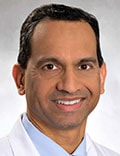New Standard of Care in Locally Advanced Head, Neck Cancer?
Adding neoadjuvant and adjuvant pembrolizumab to the standard of care significantly improved event-free survival in patients with previously untreated, locally advanced head and neck squamous cell carcinoma (HNSCC), according to data from the first interim analysis of KEYNOTE-689.
These data support changing the current standard of care in these patients to “now include neoadjuvant and adjuvant pembrolizumab,” Ravindra Uppaluri, MD, PhD, director of Head and Neck Surgical Oncology, Dana-Farber Brigham Cancer Center, Boston, said during a press briefing.

Currently, patients newly diagnosed with HNSCC undergo surgery, followed by radiation with or without chemotherapy, said Uppaluri, who presented the results during a plenary session at the American Association for Cancer Research (AACR) Annual Meeting 2025 in Chicago.
However, “this paradigm has been in place for more than 2 decades, and unfortunately, outcomes for many patients continue to be unsatisfactory,” Uppaluri explained in a press statement.
Phase 2 studies evaluating neoadjuvant and adjuvant pembrolizumab in resectable, locally advanced HNSCC have shown this approach is safe in the perioperative period and provided “intriguing” early efficacy results.
The current phase 3 active-controlled, open-label study enrolled 714 treatment-naive patients with newly diagnosed resectable, locally advanced stage III or IV HNSCC, including in the larynx, hypopharynx, and oral cavity. All patients had Eastern Cooperative Oncology Group performance status of 0 or 1 and tumor tissue for programmed cell death ligand 1 (PD-L1) testing.
Patients were randomly allocated (1:1) to receive standard of care (surgery and pathology-directed adjuvant radiotherapy with or without cisplatin) or pembrolizumab plus this standard of care.
More specifically, patients in the pembrolizumab group received two cycles of neoadjuvant pembrolizumab, followed by surgery, and then three cycles of adjuvant pembrolizumab plus radiotherapy with or without cisplatin, followed by 12 cycles of pembrolizumab maintenance therapy.
“The baseline characteristics were generally balanced between these two arms, and they were comparable to what is typically seen in clinical practice,” Uppaluri noted.
Across all patients, 3-year event-free survival was 57.6% with pembrolizumab add-on vs 46.4% without it (hazard ratio [HR], 0.73; P = .0041). Median event-free survival (after the median follow-up of 38.3 months) was 51.8 months with pembrolizumab vs 30.4 months without it. Notably, distant progressive disease occurred significantly more often without pembrolizumab (14.5% vs 7.2%).
Results were similar in patients with PD-L1 combined positive score (CPS) ≥ 10 and CPS ≥ 1.
In the PD-L1 CPS ≥ 10 population, 3-year event-free survival was 59.8% with pembrolizumab vs 45.9% without the standard of care group (HR, 0.66; P = .0022). Patients on pembrolizumab lived a median of 59.7 months vs 26.9 months vs the standard of care group. Distant progressive disease occurred in fewer patients in the pembrolizumab group vs the standard of care group (6.4% vs 16.9%).
In the PD-L1 CPS ≥ 1 population, 3-year event-free survival was 58.2% in the pembrolizumab group vs 44.9% in the standard of care group (HR, 0.70; P = .0014). Median event-free survival was again about twice as long in the pembrolizumab group (59.7 months) vs the standard of care group (29.6 months).
The pembrolizumab regimen also met the key secondary endpoint of statistically significant improvement in major pathological response in all patients.
Overall survival did not reach statistical significance at the first interim analysis; additional follow-up is ongoing for overall survival and will be reported in the next interim report.
Grade 3 or higher treatment-related adverse events occurred at similar rates in both groups. Total immune-mediated adverse events were, however, more common in the pembrolizumab group (43%) vs the standard of care group (10%).
This is a “highly impactful and potentially practice-changing trial, which seems to represent a potential new therapeutic option for these patients,” said Ryan B. Corcoran, MD, PhD, from Mass General Research Institute, Boston, who moderated the briefing and is co-chair of this year’s annual meeting clinical trials committee.
Skip Surgery?
“Now that we know this is a safe approach, we can start thinking about how we can potentially modify surgery and/or the adjuvant therapy to try to reduce the challenges patients face from the side effects of our treatments,” said Uppaluri.
During the press briefing, the study author was asked about the possibility of sparing some patients surgery with this approach, based on the initial response.
“I’m a surgeon,” he said, but “absolutely. I do think that’s where we’re headed.”
It’s “very exciting,” he added, “because in head and neck cancer, in particular, this really sets the stage for us to think about other approaches. This opens up the idea of considering additional immunotherapy approaches upfront, whether it’s doublets or combination approaches, that may lead to better pathological responses, which, again, ultimately can — sorry to say this — get rid of surgery.”
The US Food and Drug Administration has accepted priority review for a supplemental biologics license application from Merck, seeking approval for pembrolizumab for the treatment of patients with resectable, locally advanced HNSCC as neoadjuvant treatment, then continued as adjuvant treatment in combination with standard of care with or without cisplatin, and then as a single agent.
The application has a target action date of June 23, 2025.
The KEYNOTE-689 study was funded by Merck & Co. Uppaluri disclosed financial relationships with Merck Sharp & Dohme, Daiichi Sankyo, and Regeneron Pharmaceuticals. Corcoran reported relationships with various companies, including Alterome Therapeutics, Asana Biosciences, C4 Therapeutics, Cogent Biosciences, Erasca, FogPharma, and Guardant Health.


 Admin_Adham
Admin_Adham


